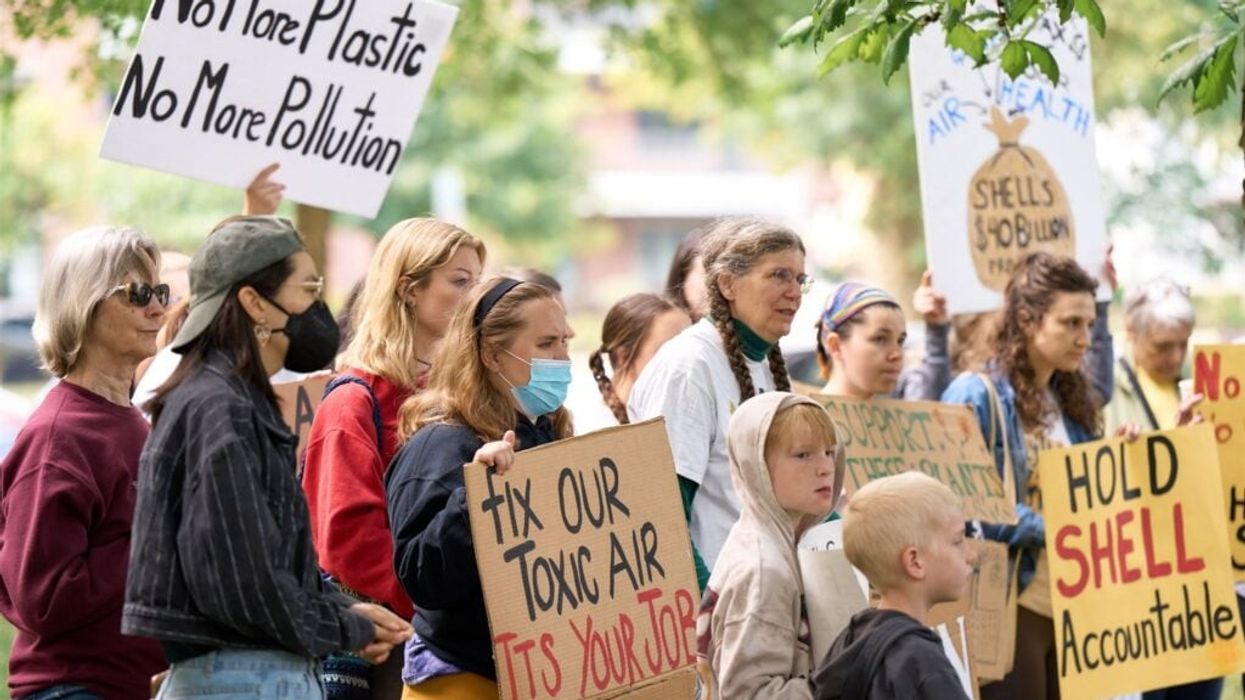With so much at stake, officials must hold Shell accountable. So we’ve joined allies to demand that accountability and ensure a healthy environment for our community.
The Fires in the Sky at Shell Polymers Monaca
A huge column of blazing flame is never a good sign. Shell would have us believe that it’s a routine occurrence to keep operations safe. But in reality, it’s often more like a distress signal.
Shell Polymers is only allowed to flare for five minutes every two hours, but it’s been flaring way too much for comfort. For instance, in February, an equipment malfunction led the plant to send a huge bolt of fire into the air for hours on end.
Flaring burns off chemicals directly into the air, with black smoke signaling a malfunction—as well as dangerous pollution. It releases particulate matter, cancer-causing benzene, and other toxic pollutants.
Shell Expels Dangerous Air Pollution Into Our Already-Burdened Community
Even before Shell Polymers Monaca came online, Beaver County residents struggled with bad air quality. The County already had an F grade for ozone from the American Lung Association.
Additionally, residents face a higher risk for cancers, heart disease, and respiratory disease—which can all be caused or worsened by the pollution from the Shell plant.
The plant is permitted to be the second-biggest emitter of ozone-causing volatile organic compounds (VOCs) in Pennsylvania. But while Shell is capped at 516.2 tons of VOC pollution for any 12-month period, it emitted 510.89 tons in September 2022 alone—before it even started operations. With every following month, it flew by its 12-month permit limits.
from November to May, the plant racked up over a dozen air permit violations and blasted through its limits for carbon monoxide, nitrogen oxides, and other hazardous air pollutants.
That’s in part because of equipment malfunctions that began a mere 12 hours after the plant began operations. From September 5 to October 7 alone, these malfunctions led to 350 tons of excess VOC pollution.
These VOCs are no joke. They cause eye, nose, and throat irritation; headaches; and nausea. Long-term, they can damage the liver, kidney, and nervous systems; worsen asthma; and cause cancer.
What’s more, from November to May, the plant racked up over a dozen air permit violations and blasted through its limits for carbon monoxide, nitrogen oxides, and other hazardous air pollutants. The plant also emits air pollutants like sulfur dioxide, particulate matter, and benzene during routine operations.
In April, Shell’s fenceline monitoring system clocked sickening levels of benzene, due in part to the 219 pounds of benzene it leaked in a single day. That’s more than 21 times the amount that triggers reporting requirements under our country’s major toxic pollution law.
The Shell Plant Contributes to Our Plastic Pollution and Climate Crises
Shell Polymers has huge consequences not just for the local community, but for the planet and the climate. In a time of crisis-level plastic pollution, these plants turn ethane (derived from natural gas) into ethylene, a key ingredient in many plastics.
The Beaver plant will produce up to 3.5 billion tons of plastic pellets a year, much of them destined to become single-use plastics. And these single-use plastics are the major contributors to the plastic pollution crisis.
Plants like these are linchpins in our linked plastic and climate crises. They drive more drilling and fracking to supply ethane. One researcher estimates that a plant the size of Shell’s would need 1,000 wells to supply it. The plant itself is expected to have the same annual greenhouse gas emissions as 430,000 extra cars on the road.
This Plant Was Built on False Promises
The Shell plant was originally planned as part of a network of facilities. Politicians on both sides of the aisle lauded it as the start of an industrial renaissance.
In its excitement, the Pennsylvania state legislature bestowed a hefty $1.7 billion tax credit on the facility, the largest of its kind in state history. Shell touted an expected billions of dollars in economic impact for the state. It promised the plant would create jobs, generate income taxes, and attract more business.
But these turned out to be empty promises. In the more than 10 years since the plant was announced, Beaver County has seen none of the promised windfall.
Instead of bringing jobs in booming green energy and manufacturing, lawmakers chose Shell’s pollution and profits.
According to the Ohio River Valley Institute, the County has lost population, business, and GDP, even as the rest of the state and country grew. It also fell behind the state and nation in job growth and in reducing poverty.
Instead of bringing jobs in booming green energy and manufacturing, lawmakers chose Shell’s pollution and profits.
We Stand at the Start—but Far From the End—of Accountability for Shell
In May 2023, Shell finally agreed to pay $10 million for its permit violations. Of that, $5 million will fund environmental projects in Beaver County. And this historic Environmental Mitigation Community Fund is one of the largest in state history.
Food & Water Watch’s leadership in this fight and our allies’ tireless watchdogging made sure that Shell’s actions wouldn’t slip by unnoticed.
But this isn’t the end. In its agreement with DEP, Shell said it already expects to violate its 12-month emissions limits into the fall. Nevertheless, the plant will continue to operate. The $10 million penalty is the bare minimum, as Shell continues to pollute this region and sacrifice its neighbors’ health for profit.
Moreover, it’s become increasingly clear that local governments aren’t equipped to handle the hazards of big polluters like Shell. Recently, county officials have pulled out of an important community meeting to address emergency response.
We deserve a healthy environment and freedom from the fear of deadly pollution. We deserve leaders who aren’t so afraid of Shell that they turn their backs on our communities.

